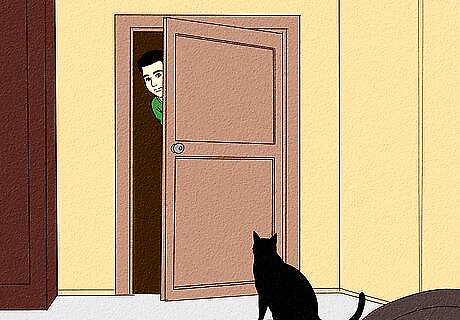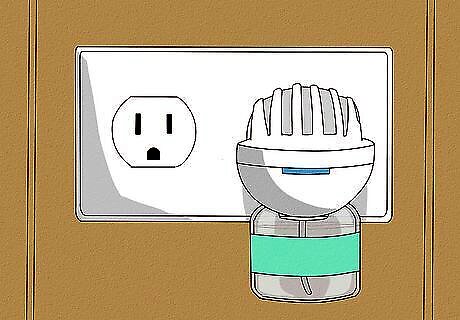
views
Moving Your Cat

Make sure your cat is micro-chipped. Before you move it's important to take some steps which will prepare your cat. If the worst happens and your cat does run away, ensuring that they have been micro-chipped will mean they are fully registered and can be returned to you if they are picked up or found. Most cats now are micro-chipped. Your vet can do this quickly and easily and it doesn't hurt or distress your cat. A tiny microchip is inserted under the skin which can be quickly scanned by a vet. The chip will have all of the owner's details on so you can be quickly reunited. You need to update your details when you move or if you change phone number, since the database is only as good as the information you give it.

Get a collar with your phone number on. A more old-fashioned way to identify your cat is to get her a collar with your phone number on. This way if they sneak off and get lost, or heads back to your old house and someone finds them, they can quickly and easily get in touch with you. This is a cheap and simple thing to do but it could make a big difference. It's sensible to leave your phone number for the people moving into your old house in case your cat heads back there.

Prepare a basket. Before the move make sure you have a suitable cat carrier that will last the journey without falling apart or breaking. They will have to stay in the basket for quite a while, and it can be a very stressful experience for a cat. Take some time to make it comfortable with their favourite blanket. Let them get used to the basket before you try to get them to go into it. You can do this by leaving the basket out in the house for a few days before the move. You can even put a little piece of dried food in there to encourage them in.

Isolate your cat from the moving mayhem. Moving is stressful for everyone, your cat included. While all the packing is taking place keep your cat in one room with everything they need. When it comes to the day of the move it is especially important to isolate your cat from the stress and noise. Consider using Feliway, a calming pheromone product for cats, starting two weeks before the move, allowing it plenty of time to take effect. Keep them in one room, which should be kept closed off all day. Make sure everybody knows that the cat is in there and it must remain closed. It's advisable to put them into the room the night before the move and keep them in there overnight.
Keeping Your Cat in One Room Initially

Prepare a room for the cat. Before you bring your cat into your new house, you should prepare a room that you will keep them in for the first few days. Make sure the room is fully equipped with all their favorite toys and blankets. You also need to have enough food and water, as well as a litter tray, and all food and water dishes. Cats rely on scent, so putting furniture in the room that smells of you can also help. Put a sign on the door and tell the movers not to open it, a panicked cat could make a run for it. You should also make sure all your family know which room you are keeping the cat in when you move.

Keep the cat in their basket during the move. Your cat should be the last thing you move. Once you have moved all the boxes and furniture, bring your cat in while they're in the basket. Take them into the room you have prepared, but keep them in their basket while there is still a lot of comings and goings.

Allow the cat to explore this room. Once the move is complete and a semblance of normality is returning you can ease your cat into their new surroundings. The key to helping them successfully acclimate to the new house is to move gradually. You should keep them in the one room for the first few days, but you can let them out of their basket to explore the room once the moving noise has died down. When you open up the cage or basket, spend some time sitting with them in the room to help put them at ease. Give them some food or treats. Don't worry if they go and hide in a corner or under a bed somewhere, they are just taking time to adjust to their new surroundings. Be patient with them and don't try to force them out of cover.
Gradually Allowing Access to More Rooms

Open up more rooms. After a couple of days you can begin to allow your cat to explore some more of the house. After making sure that all potential routes outside are closed and secured, invite them to have a look around a few more rooms. Gradually allowing access to other spaces will help to lower their anxiety. Keep an eye on them when you allow them to explore more and be on-hand to comfort or play with them if they appear stressed. If you have a cat leash, you could use it to make sure they are unable to make a run for it. If your cat is not used to a leash this could just make them even more stressed out.

Consider using a pheromone diffuser. You can use a plug-in pheromone diffuser to release scents that are designed to calm stressed cats. You can buy these from your local pet store or vet, and they help to create a more reassuring environment after a move. It is a particularly good idea to use one in the room your cat will be spending a lot of time in at the start. Different cats will react in different ways to these diffusers and some may not react at all. You could keep some catnip handy as an alternative.

Be patient. It's important to be relaxed around them, and to allow them plenty of time to adjust to their new surroundings. They might take a while to get back to their old personality, becoming more withdrawn or quiet after the move. Showing patience and sensitivity will help to reduce any anxieties and create a comfortable and welcoming environment.

Keep them indoors for two weeks. While you gradually introduce them to their new house, it's important that you don't allow them to get outside yet. Keep them in the house for two weeks so they can become fully acclimated to their new surroundings before you let them out. Spending this long in the new house helps to establish it as her new base, and lower the chances of her trying to make her way back to the old house. Take extra care to make sure your don't leave doors or windows open in this period and generally be observant and careful. If you have a very adventurous cat who is desperate to go outdoors, don't give in. Keep them in for a minimum of two weeks; the amount of time depends on the disposition of the individual cat.
Introducing Your Cat to Your New Garden

If possible, close off a space in your garden. When you are ready to introduce your cat to your back garden the same rule of gradual exposure applies. If you can, block off a small area of your garden to do this. Let them into this closed off area to be exposed to the sights and sounds of your garden. An enclosed space should be one where there is no chance of them getting out to a road or escaping over a fence into a neighboring garden. When you take them out, you should stay close to them and be attentive.

Don't force them out. If your cat doesn't want to go outside, then they are probably still adjusting to the new house and is not yet completely comfortable. The adjustment period can vary so don't force them outside, this will only stress them out more. Be patient and let them go at their own pace.

Allow them to walk around supervised for short periods. Take them out into the garden for short periods and let them explore. Keep a close eye on them at all times, and take a toy and a couple of treats to help put them at ease. Start with short periods and gradually increase them as she becomes more accustomed. Begin with a few minutes at a time and go from there. Always ensure there is an easy route back into the house if they get spooked or want to dash back in. Leave a door wide open for them and don't block it off.




















Comments
0 comment